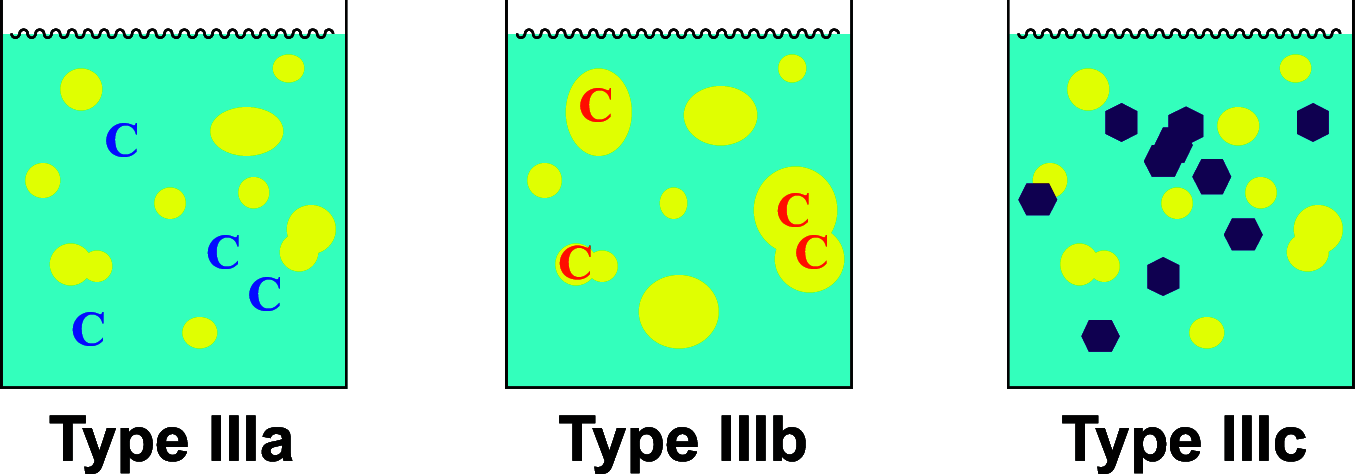Synthetic Organic "Aquachemistry" that Relies on Neither Cosolvents nor Surfactants
- PMID: 34079894
- PMCID: PMC8161484
- DOI: 10.1021/acscentsci.1c00045
Synthetic Organic "Aquachemistry" that Relies on Neither Cosolvents nor Surfactants
Abstract
There is a growing awareness of the underlying power of catalytic reactions in water that is not limited to innate sustainability alone. Some Type III reactions are catalytically accelerated without dissolution of reactants and are occasionally highly selective, as shown by comparison with the corresponding reactions run in organic solvents or under solvent-free conditions. Such catalysts are highly diversified, including hydrophilic, lipophilic, and even solid catalysts. In this Outlook, we highlight the impressive characteristics of illustrative catalysis that is exerted despite the immiscibility of the substrates and reveal the intrinsic benefits of these enigmatic reactions for synthetic organic chemistry, albeit with many details remaining unclear. We hope that this brief introduction to the expanding field of synthetic organic "aquachemistry" will inspire organic chemists to use the platform to invent new transformations.
© 2021 The Authors. Published by American Chemical Society.
Conflict of interest statement
The authors declare no competing financial interest.
Figures




Similar articles
-
Synthetic Organic Electrochemistry: An Enabling and Innately Sustainable Method.ACS Cent Sci. 2016 May 25;2(5):302-8. doi: 10.1021/acscentsci.6b00091. Epub 2016 May 5. ACS Cent Sci. 2016. PMID: 27280164 Free PMC article. Review.
-
Unraveling the Chemistry of High Valent Arylcopper Compounds and Their Roles in Copper-Catalyzed Arene C-H Bond Transformations Using Synthetic Macrocycles.Acc Chem Res. 2022 Oct 4;55(19):2796-2810. doi: 10.1021/acs.accounts.2c00316. Epub 2022 Aug 22. Acc Chem Res. 2022. PMID: 35994690
-
Organic and Organometallic Chemistry at the Single-Molecule, -Particle, and -Molecular-Catalyst-Turnover Level by Fluorescence Microscopy.Acc Chem Res. 2019 Aug 20;52(8):2244-2255. doi: 10.1021/acs.accounts.9b00219. Epub 2019 Jul 16. Acc Chem Res. 2019. PMID: 31310095
-
Nanostructured catalysts for organic transformations.Acc Chem Res. 2013 Aug 20;46(8):1825-37. doi: 10.1021/ar300197s. Epub 2013 Jan 25. Acc Chem Res. 2013. PMID: 23350747 Review.
-
Recent advances on micellar catalysis in water.Adv Colloid Interface Sci. 2021 Jan;287:102299. doi: 10.1016/j.cis.2020.102299. Epub 2020 Oct 27. Adv Colloid Interface Sci. 2021. PMID: 33321331 Review.
Cited by
-
"On-Water" accelerated dearomative cycloaddition via aquaphotocatalysis.Nat Commun. 2024 May 8;15(1):3876. doi: 10.1038/s41467-024-47861-w. Nat Commun. 2024. PMID: 38719834 Free PMC article.
-
Pd-catalyzed intermolecular consecutive double Heck reaction "on water" under air: facile synthesis of substituted indenes.RSC Adv. 2023 Jun 26;13(28):19312-19316. doi: 10.1039/d3ra03510g. eCollection 2023 Jun 22. RSC Adv. 2023. PMID: 37377870 Free PMC article.
-
Exporting Metal-Carbene Chemistry to Live Mammalian Cells: Copper-Catalyzed Intracellular Synthesis of Quinoxalines Enabled by N-H Carbene Insertions.Angew Chem Int Ed Engl. 2021 Sep 27;60(40):22017-22025. doi: 10.1002/anie.202108899. Epub 2021 Aug 26. Angew Chem Int Ed Engl. 2021. PMID: 34390304 Free PMC article.
-
Challenges and Achievements of Peptide Synthesis in Aqueous and Micellar Media.Chembiochem. 2025 Jun 3;26(11):e202500099. doi: 10.1002/cbic.202500099. Epub 2025 May 21. Chembiochem. 2025. PMID: 40289017 Free PMC article. Review.
-
Recent Advances in the Development of Greener Methodologies for the Synthesis of Benzothiazoles.Curr Top Med Chem. 2025;25(5):581-644. doi: 10.2174/0115680266347975241217112119. Curr Top Med Chem. 2025. PMID: 39844549 Review.
References
-
-
“The substances do not react unless fluid or if dissolved”, quoted by Aristotle (384–322 BCE).
-
-
- Cortes-Clerget M.; Yu J.; Kincaid J. R. A.; Walde P.; Gallou F.; Lipshutz B. H. Water as the reaction medium in organic chemistry: from our worst enemy to our best friend. Chem. Sci. 2021, 12, 4237.10.1039/D0SC06000C. - DOI - PMC - PubMed
- Zhou F.; Hearne Z.; Li C.-J. Water–the greenest solvent overall. Curr. Opin. Green Sustain. Chem. 2019, 18, 118–123. 10.1016/j.cogsc.2019.05.004. - DOI
- Kitanosono T.; Masuda K.; Xu P.; Kobayashi S. Catalytic organic reactions in water toward sustainable society. Chem. Rev. 2018, 118, 679–746. 10.1021/acs.chemrev.7b00417. - DOI - PubMed
-
and references cited therein.
-
-
Recent authoritative reviews, see:
- Andersen J.; Mack J. Mechanochemistry and organic synthesis: from mystical to practical. Green Chem. 2018, 20, 1435–1443. 10.1039/C7GC03797J. - DOI
- Tan D.; Friščić T. Mechanochemistry for organic chemists: an update. Eur. J. Org. Chem. 2018, 2018, 18–33. 10.1002/ejoc.201700961. - DOI
- Do J.-L.; Friščić T. Mechanochemistry: a force of synthesis. ACS Cent. Sci. 2017, 3, 13–19. 10.1021/acscentsci.6b00277. - DOI - PMC - PubMed
-
and references cited therein.
-
-
- Wöhler F. Ueber künstliche Bildung des Harnstoffs. Ann. Phys. 1828, 87, 253–256. 10.1002/andp.18280870206. - DOI
Publication types
LinkOut - more resources
Full Text Sources

